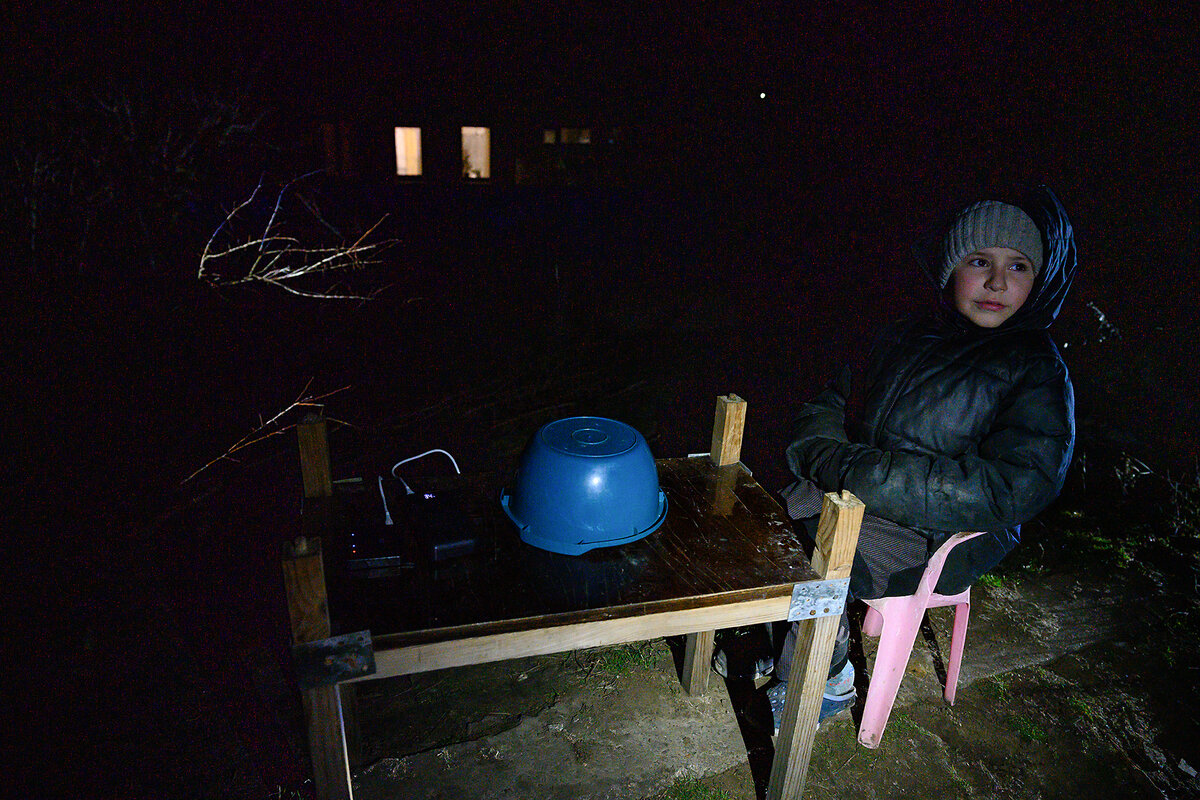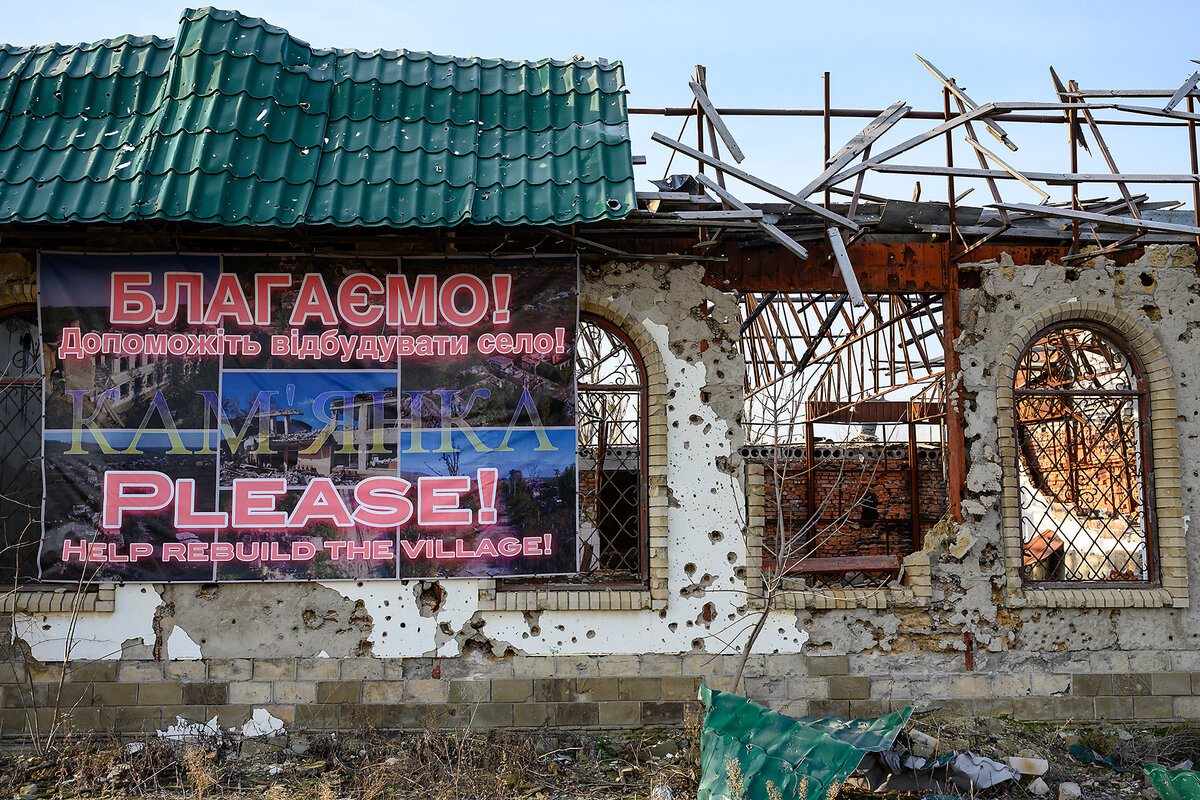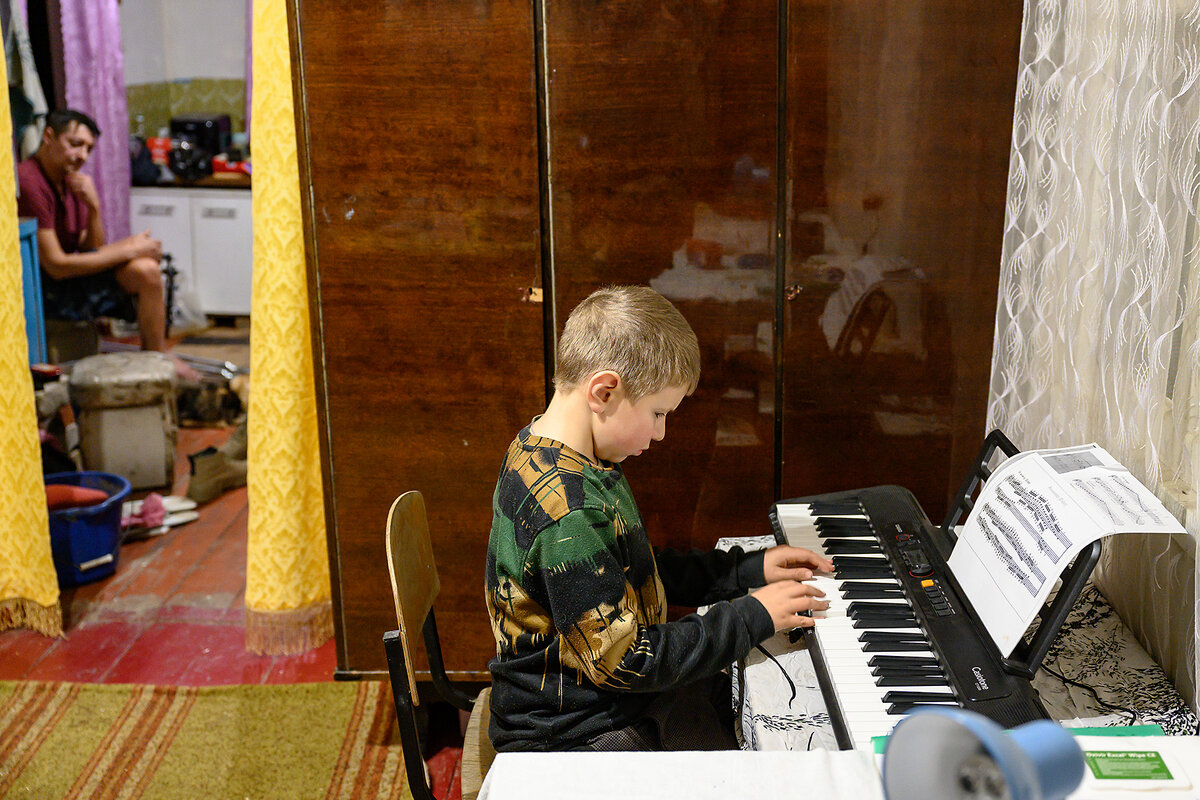Amid war’s ruins, a family grapples with young son’s hunger to learn
Loading...
| Kamianka, Ukraine
In front of a house on a slight rise in this destroyed village, on a road of frozen mud, sit a tiny wooden table and a pink plastic chair.
On the table is a small router with a SIM card that sends the internet to the house below. It is protected from the elements by an overturned plastic bowl, held in place by half a brick.
For Artem Aharkov, a 10-year-old boy, it is hallowed ground, the modest setup of an altar of learning.
Why We Wrote This
A story focused onUkrainian families in front-line regions grapple daily with formidable obstacles as they try to rebuild their lives amid the destruction of Russia’s invasion. Providing the electricity, phone, and internet needed for online schooling is a huge challenge.
This is where the 4G signal is best around here in Kamianka, a village in eastern Ukraine reduced to rubble and seeded with mines when Russia invaded three years ago. And it’s where Artem, a precocious and energetic youngster with a hunger for knowledge, can connect to the world – when the internet works.
When it doesn’t, his frustration grows and he throws stones at the ground, provoking a scolding from his mother. Sometimes Artem must spend hours in the bitter cold at the table, trying to get a direct signal on his mother’s phone; there is no computer.
“This is our biggest problem, that he can’t study normally,” says Antonina Aharkova, Artem’s mother and encourager-in-chief. “He’s upset when he can’t get all that knowledge.”
The phone signal can be strong in the morning but then disappear, requiring Artem to don a thick coat and wait until late at night to download homework assignments – if the signal comes back at all.
Before the new year, Artem bumped into some charity workers who asked him, “What is your dream?”
“I dream of Starlink,” he replied, “because I want to study.”
He was in luck. The charity sent him a Starlink unit, offering a reliable satellite internet connection. But it still sits in its box under a wardrobe, because the family can’t afford the $50 monthly subscription.
Online schooling, which depends on an erratic phone signal, is just one of the many challenges facing Ukrainian families like the Aharkovs, who grapple daily with formidable obstacles in front-line regions as they try to rebuild their lives amid ruined homes.
Artem’s family returned to their village in late 2022, after the immediate violence of war receded. A lightning Ukrainian counteroffensive had ended six months of Russian occupation and liberated much of the northeast Kharkiv region, including Kamianka village and the city of Izium, just to the north.
Their home had been severely damaged. “There was nothing, all the windows were smashed,” says Artem’s father, Oleksandr Aharkov.
“When we came in, I remember we could see the sky through the roof,” recalls Ms. Aharkova. Electricity, heat, and water were nonexistent. Solar panels helped, but when Ms. Aharkova went to work each day as a junior nurse in Izium, she carried a sack of power banks and charged them throughout the day.
There was tragedy: Ms. Aharkova’s father was killed during the occupation by Russian troops, who ran over his car in a tank and burned his house with a phosphorus charge.
The family had to demine their garden and backyard themselves, while emergency services demined roads. Despite the risks, 44 families totaling 89 people have returned.
A large sign on the wrecked village shop, visible to passing vehicles on the main paved road, reads: “Please! Help rebuild the village!”
“When we came it was really dangerous, there were mines literally lying around on the roads, and larger unexploded shells,” says Ms. Aharkova. “People were coming, seeing their houses destroyed, and leaving.”
Her family stayed, but there was further tragedy: Mr. Aharkov stepped on a mine last spring while tending cows – adding to the list of 20 local people wounded here by Russian mines in the last two years.
“There are some spots where you can walk 20 times, and then it will explode,” says Mr. Aharkov. He was saved by a mobile medical unit that serves Kamianka, which Ms. Aharkova now works for two days a week.
She was at work in Izium last Nov. 15 – she will never forget the moment, nor the date – when she received a call from an excited Artem.
“Mom, you will not believe it, but we will have electricity tonight when you come home!” the boy exclaimed. “I was so happy; I was dreaming of that,” Ms. Aharkova recalls.
But when she got off the bus, the streetlights were still off, and she needed a headlamp to get home, as usual. She thought her son had played a joke on her, but when Artem opened the front door, the house was flooded with light.
After two years, to their amazement, electricity to the village had been restored. The electric kettle boiled water, the television worked, and a game console could be used, all without a gas-guzzling generator.
Still, satisfying the educational needs of Artem, and two more boys who have returned to the village, remains a problem. All classes in Ukraine’s front-line regions are held online, to avoid students gathering in spaces that make easy targets for Russia.
One recent night, after he expressed his disgust at the failing internet signal by throwing a rock, Artem went inside the warm house and serenaded guests with an impromptu piano recital, as his proud parents looked on. He then practiced a few words he had learned in English – “Would you like coffee or tea?” – while stroking a pet cat.
He is clearly sharp, and confident. A local piano teacher has recognized Artem’s talents, and Artem would like to learn English. But language classes are expensive. And then there is the internet problem, of course.
The Starlink sits in its box, almost mocking his desire to learn.
Nevertheless, Ms. Aharkova remembers when the family first moved back, and she found a small bed she herself had used as a child.
Artem had stretched out on that bed, and smiled. “It’s so good to be home, Mom.”
Oleksandr Naselenko supported reporting for this story.









